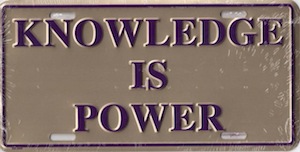 Sir Francis Bacon is commonly credited with saying “scientia potentia est” in the early 1600s. For those of us who don’t know this Latin aphorism, it stands for “knowledge is power” and was a statement of why one should seek out information in order to prosper. Marketing professionals today have taken this to extremes courtesy of the massive amounts of data available on buyer personas, information consumption patterns and value exchange effectiveness as part of the buyer’s journey.
Sir Francis Bacon is commonly credited with saying “scientia potentia est” in the early 1600s. For those of us who don’t know this Latin aphorism, it stands for “knowledge is power” and was a statement of why one should seek out information in order to prosper. Marketing professionals today have taken this to extremes courtesy of the massive amounts of data available on buyer personas, information consumption patterns and value exchange effectiveness as part of the buyer’s journey.
This is why big data is becoming the life-blood of every successful marketing organization. If you can uncover and exploit these patterns effectively then you will engage your targeted prospects before your competition in such a way as to engender loyalty and ultimately a satisfied customer. First, of course, you will need to track the data using tools like Hubspot, Marketo, or Eloqua or any of the hundreds of other marketing automation tools available. What is important to gather is:
- Who is coming from where, how often and how long?
- What value exchange items do they consume, when from where and how often?
- Where in the sales process has this engagement come and what position in the evaluation and acquisition team is this person?
- What combination of activities (and people/personas) lead to an opportunity being created and then a deal closed?
- Where do the bottlenecks appear and how do the equations shake out for lead-to-cash?
Stephanie Overby suggests in a CIO.com blog recently that “To make sense of all of those bits and bytes, corporate marketing leaders must put together an effective Big Data team, stitching together internal and external experts in areas like advanced mathematics, predictive analytics, high-performance computing, and economics, and integrate them with their more traditional creative and business analysts on staff as well as the larger enterprise.” She then offers 10 Steps To Building A Winning Big Data Team which I wholly support and suggest you take to heart in your planning for next year.
The good news is that data is plentiful and the means to mine that data readily available. It will just take a concerted effort by you to do what is necessary to make it work for you rather than against. Take the time to segment out persona profiles, information consumption patterns, and value exchange effectiveness in order to turn data into profits instead of confusion because “knowledge is power” when wielded effectively.

Recent Comments